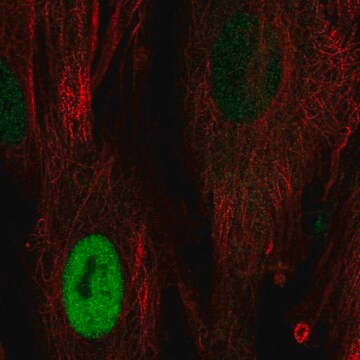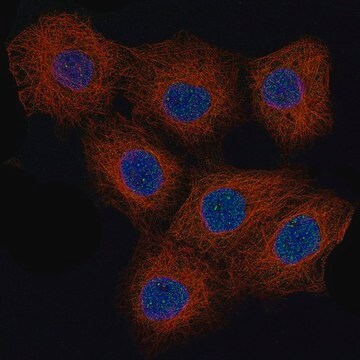一般說明
We are committed to bringing you greener alternative products, which adhere to one or more of The 12 Principles of Green Chemistry.This antibody is Preservative-free, produced without the harm or sacrifice of animals and exceptionally stable to allow for ambient shipping and storage if needed and thus aligns with "Waste Prevention", "Designing Safer Chemicals" and "Design for Energy Efficiency".
Click here for more information.
ZooMAb® antibodies represent an entirely new generation of recombinant monoclonal antibodies.Each ZooMAb® antibody is manufactured using our proprietary recombinant expression system, purified to homogeneity, and precisely dispensed to produce robust and highly reproducible lot-to-lot consistency. Only top-performing clones are released for use by researchers. Each antibody is validated for high specificity and affinity across multiple applications, including its most commonly used application. ZooMAb® antibodies are reliably available and ready to ship when you need them.
特異性
Clone 1B9 is a ZooMAb® Rabbit recombinant monoclonal antibody that specifically detects MAPK2/Erk2. It targets an epitope within 15 amino acids from the N-terminal region.
免疫原
KLH-conjugated linear peptide corresponding to 15 amino acids from the N-terminal region of human MAPK 2/Erk2.
應用
Quality Control Testing
Evaluated by Western Blotting in K562 cell lysate.
Western Blotting Analysis: A 1:1,000 dilution of this antibody detected MAPK2/Erk2 in K562 cell lysate.
Tested Applications
Western Blotting Analysis: A 1:1,000 dilution from a representative lot detected MAPK 2/Erk2 in lysates from Mouse placenta, C2C12 cells, and recombinant Human MAPK2/ERK2.
Immunohistochemistry (Paraffin) Analysis: A 1:100 dilution from a representative lot detected MAPK 2/Erk2 in mouse placenta and human placenta tissue sections.
Affinity Binding Assay: A representative lot of this antibody bound MAPK 2/Erk2 peptide with a KD of 5.0 x 10-7 in an affinity binding assay.
Note: Actual optimal working dilutions must be determined by end user as specimens, and experimental conditions may vary with the end user.
標靶描述
p42-MAP kinase (UniProt: P28482; also known as Mitogen-activated protein kinase 1, MAP kinase 1, MAPK 1, Extracellular signal-regulated kinase 2, ERK-2, MAP kinase isoform p42, p42-MAPK, Mitogen-activated protein kinase 2, MAP kinase 2, MAPK 2) is encoded by the MAPK1 (also known as ERK2, PRKM1, PRKM2) gene (Gene ID: 5594) in human. Erk1/2 are evolutionarily conserved proline-directed protein serine/threonine kinases that are activated in response to a variety of extracellular stimuli and mediate signal transduction from the cell surface to the nucleus. They are activated in response to a diverse range of extracellular stimuli, including mitogens, growth factors, and cytokines. Erk2 serves as an essential component of the MAP kinase signal transduction pathway. Depending on the cellular context, the MAPK/Erk cascade mediates diverse biological functions, including cell growth, adhesion, survival, and differentiation through the regulation of transcription, translation, cytoskeletal rearrangements. This cascade also plays a role in initiation and regulation of meiosis, mitosis, and postmitotic functions in differentiated cells by phosphorylating a number of transcription factors. The protein kinase domain of Erk2 is localized in amino acids 25-313. Erk2 is activated by MEK1/2-catalyzed phosphorylation at its conserved Thr-Glu-Tyr (TEY) dual phosphorylation motif Thr185/Tyr187 Erk2. In the activation scheme, MEK1 binds Erk2 and phosphorylates either a threonine or a tyrosine residue and then dissociates. The monophosphorylated Erk2 then rebinds to an active MEK1 for dual phosphorylation and completes activation. Activated Erk2 then phosphorylate Pro-Xxx-Ser/Thr-Pro sequence motif in hundreds of cytoplasmic and nuclear substrates, including transcription factors such as Ets, Elk, and c-Fos. Usually only one highly active form of Erk2 (dual phosphorylated) exists in the cell, exhibiting over 1000-fold greater activity than the unphosphorylated form. Within the cell, at any time, one may find three less active forms: one unphosphorylated enzyme, and two singly phosphorylated forms that contain phosphate either at the tyrosine or threonine residue. This ZooMAb® recombinant monoclonal antibody, generated by our propriety technology, offers significantly enhanced specificity, affinity, reproducibility, and stability over conventional monoclonals. (Ref.: Busca, R., et al. (2016). Front. Cell Dev. Biol. 4; 53; Wortzel, I., and Seger, R. (2011). Genes Cancer. 2(3); 195-209).
外觀
Purified recombinant rabbit monoclonal antibody IgG, lyophilized in PBS with 5% Trehalose, normal appearance a coarse or translucent resin. The PBS/trehalose components in the ZooMAb formulation can have the appearance of a semi-solid (bead like gel) after lyophilization. This is a normal phenomenon. Please follow the recommended reconstitution procedure in the data sheet to dissolve the semi-solid, bead-like, gel-appearing material. The resulting antibody solution is completely stable and functional as proven by full functional testing. Contains no biocide or preservatives, such as azide, or any animal by-products. Larger pack sizes provided as multiples of 25 μL.
重構
300 μg/mL after reconstitution at 25 μL per vial. Please refer to guidance on suggested starting dilutions and/or titers per application and sample type.
儲存和穩定性
Recommend storage of lyophilized product at 2-8°C; Before reconstitution, micro-centrifuge vials briefly to spin down material to bottom of the vial; Reconstitute each vial by adding 25 μL of filtered lab grade water or PBS; Reconstituted antibodies can be stored at 2-8°C, or -20°C for long term storage. Avoid repeated freeze-thaws.
法律資訊
ZooMAb is a registered trademark of Merck KGaA, Darmstadt, Germany
免責聲明
Unless otherwise stated in our catalog or other company documentation accompanying the product(s), our products are intended for research use only and are not to be used for any other purpose, which includes but is not limited to, unauthorized commercial uses, in vitro diagnostic uses, ex vivo or in vivo therapeutic uses or any type of consumption or application to humans or animals.










